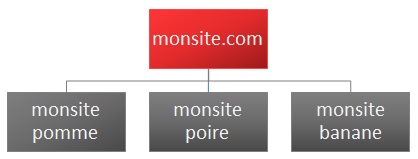Sometimes, for strategic, marketing or financial reasons, companies wish to split their website in order to better separate activities. For instance, you can be an enterprise running B2B and B2C activities and willing to clearly split them. You can also be a real estate agency which wants to separate the website into “rental”, “selling” and “acquisition” activities.

There are different ways to accomplish that. Companies can, for instance, choose to create separate domains, subdomains, or directories. If we consider the three previous solutions from a marketing perspective, the question is to know which one is best in terms of SEO.
Option 1 – Different domains
mysite-apple.com – mysite-peer.com – mysite-banana.com
With different domains, you allow the crawlers and visitors to more easily read and navigate in your content. From an SEO perspective, you have to make sure you transmit SEO link juice properly to the newly created websites. That can be done with external link-building. Actually, the main drawback here is that you have to construct everything from scratch. You will indeed have to build your websites and thus SEO historical data, which can take long.
As a matter of fact, this option is not easy to implement because you will also have to do everything three times: separated webmaster tools, different sitemaps, strict redirects, own 404, etc. Moreover, it will cost three monthly fees to host the domains. On the other hand, the structure makes the maintenance easier and it can suit companies who want to clearly separate their departments, with different management bodies.
Option 2 – Different subdomains
apple.mysite.com – peer.mysite.com – banana.mysite.com
With this structure, you can afford to put the splash page on your main domain and lead the visitors to every subdomains. Moreover, as Google considers each subdomain as a separate website, you will have your own PageRank per subdomain. A subdomain is also perceived as a good separation for the visitor and the crawler. In addition to that, the probability that your pages will show up multiple times in a search query will be decupled and therefore your competitors will be pushed down further. Link-building will also be improved with cross-linking between subdomains.
Option 3 – Different subdirectories
mysite.com/apple – mysite.com/peer –mysite.com/banana
This technique works well for small websites because the structure does not need much differentiation. If you manage a big website, this solution could not be the best. As a matter of fact, the real challenge here is to collect the right content and put it in the right category. This option is easy to implement (reassign URLs, strict redirects…) and cost a simple domain but a giant structure makes the maintenance a lot harder than the other options.
As your main website already exists, the SEO historical data’s will be preserved. Fresher content and optimized link-building have also positive impact on your ranking. However, the differentiation between categories will not be as clear for visitors and robots.
Methodology
The option you will chose will depend on your objectives and investment in SEO. Nevertheless, in every cases, make sure you respect the following best practices:
1. Make good backups2. Do not forget 301 redirects (to keep link juice):
a. Test the move process by moving one directory first
b. Prefer page-to-page redirects and avoid duplicate content
c. Make sure every old pages are at least redirected to a new page
3. URL definition - Choose between:a. EN URL website à Excellent structure but SEO lower
b. FR/NL URL website à Excellent SEO but structure complicated
4. SEA to compensate risks of loss of traffic caused by the launching of the new websites during the first months5. Update both external and internal links to pages on your site
6. Add your new websites to Webmaster Tools, verify ownership and submit sitemaps
7. Keep both your new and old sites verified in Webmaster Tools:
a. Make sure the 301s are working properly
b. Make sure the new website is not showing unwanted 404 errors
![]() written by Neda Sekkat
written by Neda Sekkat


